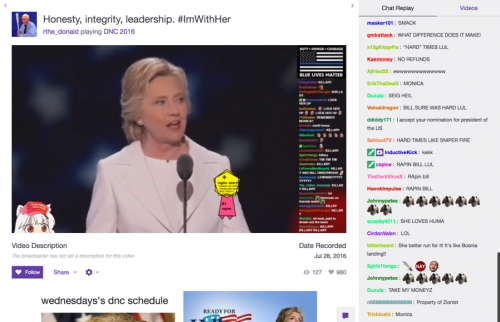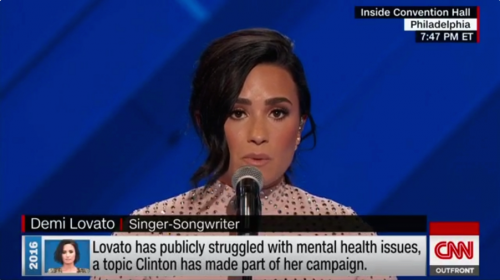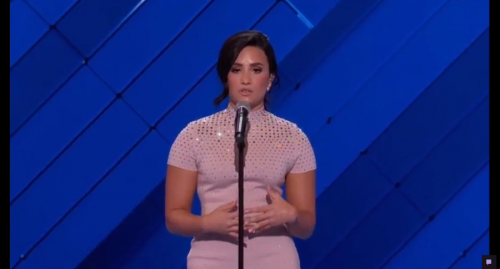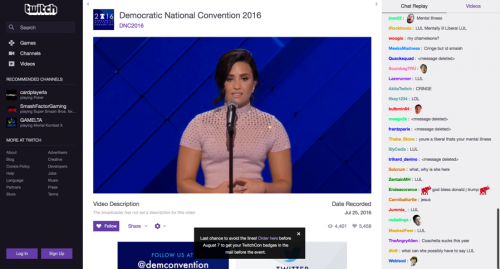Throughout their history, national conventions for American political parties have become more and more public events. Closed off affairs in smoky rooms and convention halls gave way to televised roll calls and speeches. In the Year of Our Big Brother, 1984, C-SPAN aired uninterrupted coverage of the Democratic and Republican conventions. Conventions became more polished and choreographed, with 1996’s DNC being the zenith of this trend. Conventions moved to the internet in the aughts, using a variety of different platforms to distribute streams and commentary.
This election cycle incorporated something new into the dissemination of gavel-to-gavel coverage of the conventions: Twitch.tv. The platform designed for videogame streaming offered full coverage of the conventions. Additionally, it gave Twitch users the ability to host the coverage of both conventions on their own channels. In the case of the DNC, Twitch users were able to add commentary to the stream of the convention on their channel, giving their followers and other users an opportunity to hear their favorite gamers’ takes on the presentation of the Democratic National Committee.
But why did the RNC and DNC take this step? Twitch’s announcement of the collaboration points towards granting accessibility, giving users a voice in the political process, and emphasizes the exceptional power of American politics throughout the world. While this explains Twitch’s rationale for the partnership, it is necessary to understand how the platform fits into the landscape of American coverage of conventions for this election cycle and the future.
A partial explanation is available through the concepts of remediation, immediacy, and hypermediacy offered in Jay David Bolter’s and Richard Grusin’s Remediation: Understanding New Media. Bolter and Grusin use remediation as a way to explain how media ecologies evolve over time—how and why certain mediums gain usage and importance. The significance of digital images, they argue, could only be understood through the successive supremacies of perspective, photography, and film. Each of these added some aspect to the previous medium, they argue, allowing those technologies to gain dominance in a particular time—perspective to the Rennaissance, photography to the nineteenth century, film to the twentieth, and so on.
Remediation works through the two concurrent and competing logics of immediacy and hypermediacy, which create different experiences based on how they flow back and forth in a particular media object. Immediacy is the erasure of a medium’s qualities in order to get at the heart of what is “really” there, with the full immersion of virtual reality as its ultimate form. Along and against immediacy is the logic of hypermediacy, which “makes us aware of the medium or media.”
Bolter and Grusin discuss illuminated manuscripts and Gothic cathedrals as hypermediated mediums, but we can see it plainly in cable news representations of the conventions. Here, conventions are presented not as their own experience, not as events to immerse oneself in, but something to be picked apart and digested prior to and synchronized with the event. Cable news outlets offer banners that chop speeches up into the headlines and talking points that will be repeated by analysts and commentators.
This year CNN emphasized the lower interactivity of television by acting as a sort of Google for their viewers. When airing speeches of non-headliners a banner underneath would offer factoids for the audience to understand who they were and occasionally why they were there. By using these banners, we see a medium that is aware of its place in the media environment, keeping eyes on the screen instead of wandering towards a second screen for further information.
While cable news offered a hypermediated presentation of the conventions, Twitch streams sought to enforce their qualities of immediacy. With Twitch’s Theater Mode enabled and chat disabled, the immediacy of the DNC was readily apparent. With the exception of a small Twitch icon in the lower left-hand corner and the toolbar that pops up when a cursor moves over it, the user is presented with the immediacy of an uncluttered video feed.
However, this is not what a viewer is presented with if they are not a Twitch user or fluent in the various buttons and toolbars that accompany the base Twitch layout. Instead, those viewers are presented with this:
This seems to be a textbook case of hypermediacy, especially since Bolter and Grusin explain that “hypermediacy expresses itself as multiplicity.” The chat, sidebar, and a channel description box filled with links to other DNC-related websites and social media accounts present viewers with discrete content streams. The chat moves by quickly, enforcing the constant presence of the commenter swarm. In the archiving of these livestreams (all eight days of streams are archived on the respective convention Twitch channels), the chat is preserved alongside and in time with the archived stream. The howling masses, and their prime place in the platform, concretely linked with the event itself.
But, I think this is where Bolter and Grusin’s discussion of immediacy and hypermediacy falls apart a bit. Throughout their book, these flows are often presented as a ratio—that the experience acts as a point that moves back and forth along a continuum between the poles of immediate and hypermediate. A viewer might only experience immediacy or hypermediacy at any single moment, but encountering one does not necessarily diminish the force of the other. Twitch’s chat function—because it moves by too quickly for any viewer to read everything—demonstrates that hypermediacy and immediacy are realized through a constant and complex negotiation between the technology’s affordances, a viewer’s attention, and user practices. Viewers see snippets, single words, the small icons Twitch dubs emotes, or the angle brackets denoting something that a moderator deleted. They might not even see it that often if paying attention to the stream, the random messages off to the periphery of their vision. I suggest that this is equal parts hypermediate and immediate because of this blurring and meshing of experience.
Bolter and Grusin describe immediacy as emphasizing the “contact point between the medium and what it represents.” When the thing being represented is a raucous convention in this, The Cycle of Our Trump 2016, an indistinct frenzy of comments, cheers and jeers directly connects the medium to the convention floor. It just made sense in the last few weeks, as it will in September for the first debates, where a shouting chat scroll has been and will be connected to Boisterous Trump.
Where Twitch goes from here with streaming political events remains to be seen. Webcasting has been a large part of political discourse in the US since the 1990s and the time of the “information superhighway.” From Bill Clinton’s Online Town Hall to Barack Obama’s Google+ Hangout, video streaming has been used as ways to demonstrate the possibility of closing the gap between the highest representative of government and their constituents. As I mentioned, Twitch will likely be a space where the September debates are streamed, since in 2012 both YouTube and Xbox Live streamed the debates for their users (with Xbox Live even offering real-time polls to its viewers).
However, the most interesting part of Twitch taking on these events is the possibility for users to simultaneously stream and comment on the events. The DNC allowed users to easily stream their own responses to the convention as it unfolded, which gives users the ability to put on their own telling of the conventions for their subscribers and any other viewers. They were able to use their own channel’s overlays and banners, or talk directly over the speeches. The RNC, in contrast, only allowed users to participate through Twitch’s Host mode, which only allowed users to syndicate the RNC stream on their channels. During this past convention, the permission to co-stream the events is where the chaos and vitriol of Twitch took over, especially with oversight focused on the main RNC and DNC channels.

While streams can always be hijacked by chattering assholes and hosts are able to overlay their own rubbish politics, Twitch can offer a different way of presenting events and commentary to viewers. While CNN offers us tidbits about speakers in their banners, users might be able to offer real-time fact checking or other relevant information during speeches. Streams could give us issue positions and voting history of elected officials. A coordinated effort that conglomerated different channels could give viewers various viewpoints from which to see the convention—a sort of Gore-Vidal point/counterpoint baked into the presentation of the same event. These approaches could emphasize the hypermediacy of Twitch in ways that cable news has while not slipping into a discourse of objectivity that is inevitably infused into mediums of immediacy.
In Twitch’s announcement of the RNC/DNC partnership they wrote that it was “an opportunity for [users] to engage in the political process…without leaving your native habitat, using the social and communication tools you know and love.” While positioning this as a “public service” is beneficial for Twitch, any possibility for resistant approaches to these events will be stymied if the user base and common practices of viewers and chatters are not altered. Just as broadcast networks did not push for guerilla television, Twitch will not guide its streamers and channels in creating alternative futures. Instead the mediation of change will come down from new users pushing into this “native habitat” of gamers.
Bolter and Grusin naturalize the evolution towards immediate media by explaining that hypermediacy “reminds us of our desire for immediacy.” This argument is steeped in ideals of objectivity that have been mirrored by journalistic practices over the last century. The camera, banners of quotes and factoids, and graphics displaying the time and place of the video all seek to present the event as it “naturally” is. These procedures exhibit a single view of the experience, placing politics as a distinct object, out there in the world for viewers to consume objectively. The potential of a service like Twitch is that we may start building a more evocative and self-aware form of depicting these events. One that eschews the immediacy and false objectivity of cable news and revels in the hypermediacy of multiple voices contributing to a single project. This sort of goal would create a deeper and more profound consciousness that politics are personal, beginning with how they are mediated.
Nick is managing editor for the Journal of Games Criticism and is on Twitter.




